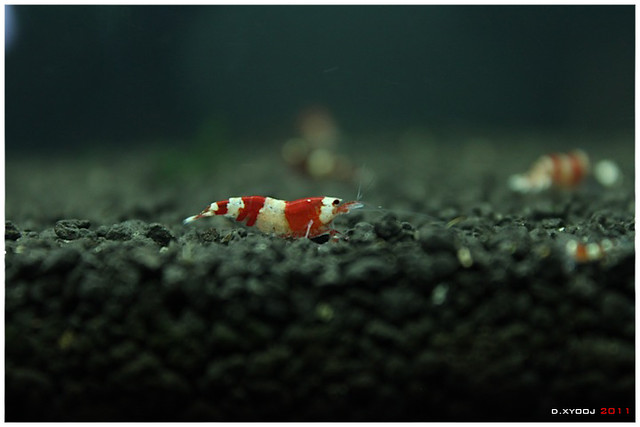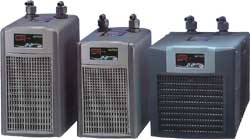
Wednesday, June 29, 2011
June Update
I moved all my CRS into one tank to make room in my other tanks for some new Tigers. Not much breeding activity from my CRS lately though; however, the shrimplets from the Spring batches are growing well and reaching juvenile age/size. The Super Tigers and OEBTs have stopped breeding as well; I suspect the warm summer weather is causing a change in their behavior. I purchased new fans to keep the tanks cool, and so far they have been working well, lowering the temperature 4-6 degrees F. Hopefully with the cooler water, they will get back into breeding mode. Still no luck with the Cardinals though. :(


Thursday, June 2, 2011
Cooling Shrimp Tanks: Chillers, Fans, and Frozen Water
With the summer season quickly approaching, it is inevitable that the weather will become warmer, which in turn may increase temperatures in shrimp tanks. With the exception of the Sulawesi species of shrimp, most shrimp in the hobby prefer cooler temperatures, though they may tolerate higher temperatures if the change isn’t too drastic.
I like to keep my tanks between 72ºF and 77ºF; however, because my tanks are not in a space where I can control the room temperature, the temperatures of my tanks fluctuate according to the weather. It is especially brutal in the summer, as outside temperatures reach up to, and sometimes beyond, 100ºF! Luckily, there are several ways to cool shrimp tanks.
 Chillers are a popular way to lower temperatures and are effective because temperatures can be regulated and maintained electronically; however, they are quite expensive and are required individually per tank.
Chillers are a popular way to lower temperatures and are effective because temperatures can be regulated and maintained electronically; however, they are quite expensive and are required individually per tank.
 Another popular method is the use of fans. There are many companies that make cooling fans for aquariums; however, small computer fans work well (and are cheaper!). They do tend to evaporate water quickly though.
Another popular method is the use of fans. There are many companies that make cooling fans for aquariums; however, small computer fans work well (and are cheaper!). They do tend to evaporate water quickly though.
 Another method is freezing water in bottles and floating them in the tank. In my experiment with this method, I measured the temperature of one of my 10 gallon tanks at 81.8ºF, floated 450mL of frozen water in a bottle, and recorded the time it took for all the water in the bottle to melt. After approximately one hour, all the ice melted and the temperature dropped to 80.3ºF. This is a cost effective way of lowing the temperature; however, there is no way to maintain a desired temperature and one would have to continually add frozen bottles.
Another method is freezing water in bottles and floating them in the tank. In my experiment with this method, I measured the temperature of one of my 10 gallon tanks at 81.8ºF, floated 450mL of frozen water in a bottle, and recorded the time it took for all the water in the bottle to melt. After approximately one hour, all the ice melted and the temperature dropped to 80.3ºF. This is a cost effective way of lowing the temperature; however, there is no way to maintain a desired temperature and one would have to continually add frozen bottles.
I currently use computer fans to cool my tanks, especially those of my Tiger shrimp varieties, as they seem to be more sensitive to warmer temperatures. I also keep the tops of my tanks open, which is helpful in dissipating heat.
I like to keep my tanks between 72ºF and 77ºF; however, because my tanks are not in a space where I can control the room temperature, the temperatures of my tanks fluctuate according to the weather. It is especially brutal in the summer, as outside temperatures reach up to, and sometimes beyond, 100ºF! Luckily, there are several ways to cool shrimp tanks.
 Chillers are a popular way to lower temperatures and are effective because temperatures can be regulated and maintained electronically; however, they are quite expensive and are required individually per tank.
Chillers are a popular way to lower temperatures and are effective because temperatures can be regulated and maintained electronically; however, they are quite expensive and are required individually per tank. Another popular method is the use of fans. There are many companies that make cooling fans for aquariums; however, small computer fans work well (and are cheaper!). They do tend to evaporate water quickly though.
Another popular method is the use of fans. There are many companies that make cooling fans for aquariums; however, small computer fans work well (and are cheaper!). They do tend to evaporate water quickly though. Another method is freezing water in bottles and floating them in the tank. In my experiment with this method, I measured the temperature of one of my 10 gallon tanks at 81.8ºF, floated 450mL of frozen water in a bottle, and recorded the time it took for all the water in the bottle to melt. After approximately one hour, all the ice melted and the temperature dropped to 80.3ºF. This is a cost effective way of lowing the temperature; however, there is no way to maintain a desired temperature and one would have to continually add frozen bottles.
Another method is freezing water in bottles and floating them in the tank. In my experiment with this method, I measured the temperature of one of my 10 gallon tanks at 81.8ºF, floated 450mL of frozen water in a bottle, and recorded the time it took for all the water in the bottle to melt. After approximately one hour, all the ice melted and the temperature dropped to 80.3ºF. This is a cost effective way of lowing the temperature; however, there is no way to maintain a desired temperature and one would have to continually add frozen bottles.I currently use computer fans to cool my tanks, especially those of my Tiger shrimp varieties, as they seem to be more sensitive to warmer temperatures. I also keep the tops of my tanks open, which is helpful in dissipating heat.
Subscribe to:
Comments (Atom)
